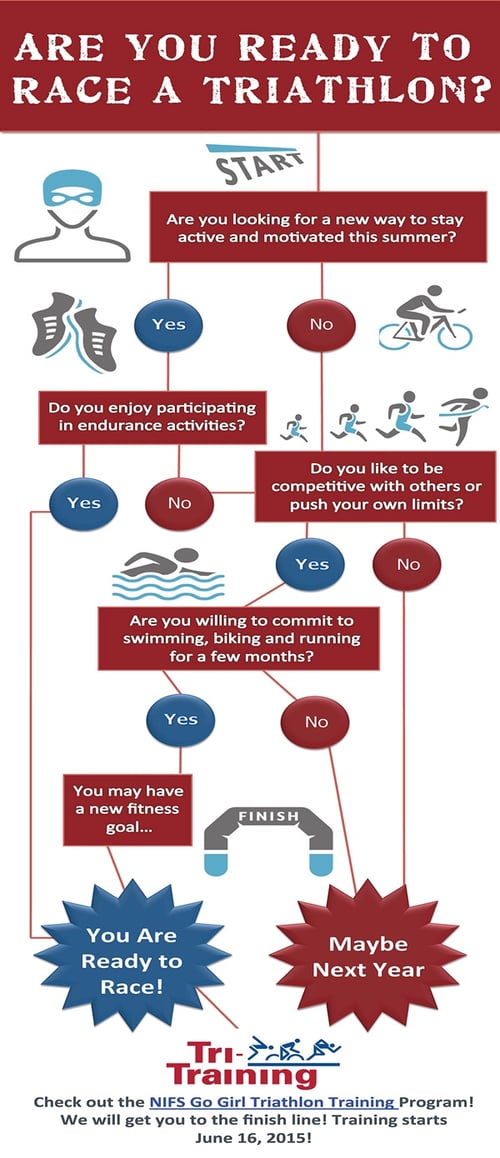
by Stephanie Kaiser, on May 21, 2015 11:25:28 AM
by Stephanie Kaiser, on May 7, 2015 11:06:46 AM
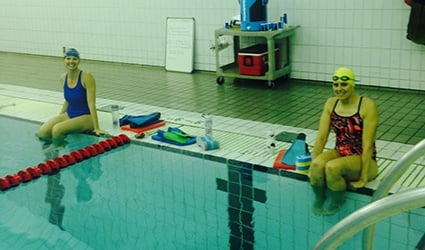 You have heard it over and over again: If you are not swimming, you are missing out on a great low-impact, total-body workout. If you were sore from beating yourself up from running on the roads or lifting earlier in the week, you will find yourself feeling much better after a good swim.
You have heard it over and over again: If you are not swimming, you are missing out on a great low-impact, total-body workout. If you were sore from beating yourself up from running on the roads or lifting earlier in the week, you will find yourself feeling much better after a good swim.
If you are like me, though, swimming is not your first choice of exercise, and you find it hard to find the motivation to get to the pool when there are so many other options that you find more enjoyable.
I am fortunate enough to have a great group of ladies who are committed to heading over to the IU Natatorium twice a week to get in a good swim session. Swimming is not my favorite fitness activity, but it has grown on me and I know that it has great health and fitness benefits*. So I have convinced myself that I need to do it! Even though we are all very committed and consistent with our swimming, we still try to talk each other out of it.
Common discussion and thoughts before and on our way to the pool:
by Stephanie Kaiser, on Dec 23, 2014 3:09:07 PM
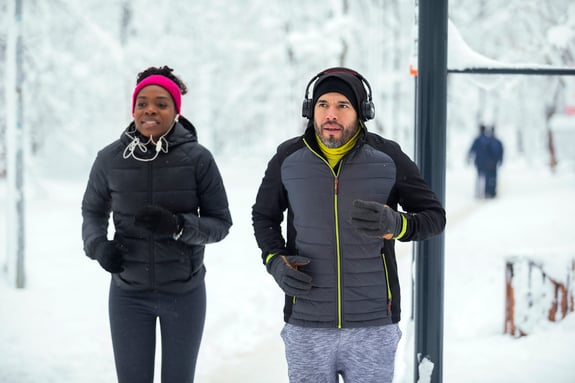
I visited Runners Forum to take a look at some of the new apparel that they have in stock this year and was very impressed with all they have to offer for this winter. After speaking with the store manager, we came up with 8 essential items you must have before you hit the streets on those cold days:
1) Running Shoes- No matter what the season it is critical that you are running in a shoe that is right for you. Not having a proper shoe specific to your body mechanics can lead to injuries or discomfort during the run or walk.
2) Wicking Base Layer- A long sleeve shirt that is efficient in wicking the moisture away from your body is important for both function and comfort. This piece is responsible for moving your sweat away from your body and out to the additional layers to keep you dry and warm.
3) Insulating Layer- This layer is generally fleece lined and continues moving moisture away from your body. It has the added responsibility of trapping body heat you are producing to keep you even warmer.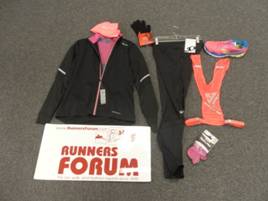
4) Wind and Water Resistant Jacket- For the most dreary days that involve sleet, rain and snow, a high-tech jacket can make a huge difference in your comfort level. Not only does it protect you from these elements, but it too will continue to wick away moisture from your body and trap your body heat.
5) Gloves and Socks- Also preferably in moisture wicking, these are crucial for keeping your fingers and toes warm and dry playing a huge factor in trapping your body heat. Additionally your fingers and toes are at a high risk of becoming frostbit on the coldest days so this is a piece that you can not afford to go without.
6) Running Tights- Since your legs are doing a majority of the work, you are producing a lot of heat in this area. Tights will be most efficient in holding in heat, but if tights are not your style, than a light insulated running pant will be your best bet.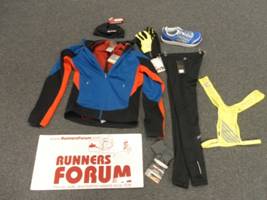
7) Winter Hat or Headband- Similar to your toes and fingers, your ears are at a high risk for frostbite. Cover your ears and head to avoid this as well as add warmth to the area for comfort.
8) Reflective Gear- In the winter, the days are shorter which means many of your runs may start or finish in the dark. To be safe, wear as much reflective clothing as you can so that you can be visible to cars and others. Many winter clothing pieces are indeed reflective but a reflective vest is a good substitute.
This blog was written by Stephanie Kaiser, Fitness Center Manager. To find out more about the NIFS bloggers, click here.
by Stephanie Kaiser, on Dec 9, 2014 11:27:25 AM
 If you’re like me, cabin fever is already starting to set in, and we are barely into the winter season. This is the time of year that I start to think about what races I want to focus in on for the upcoming year. I find it a great way to stay motivated and focused on my training when it’s not my favorite time of year to train.
If you’re like me, cabin fever is already starting to set in, and we are barely into the winter season. This is the time of year that I start to think about what races I want to focus in on for the upcoming year. I find it a great way to stay motivated and focused on my training when it’s not my favorite time of year to train.
I always consider three main questions before I pull the trigger and sign up for my first “big” race, and plan out my training program accordingly. Evaluating these things has helped me to create realistic and attainable race goals for the upcoming season, and I hope that it can do the same for you.
1. How is my year looking?
There are years where training for races can be a top priority, and others where it may be secondary or on down the line depending on what else is going on. I try to think forward and determine how much time I can and want to realistically dedicate to race training with everything else that is going on in my life. Some things to consider when thinking about this include your work schedule, vacation schedules, interest in other hobbies, taking classes, and family obligations, among many other things. Knowing these things and thinking about them as they relate to training can help you get a grasp on what you can fully commit to. Obviously, sometimes other things come up, so always know it is okay to deviate from the plan when life happens.
2. Where is my fitness today?
A late fall or holiday race can be a great reality check for how you are doing with your training currently. Even if you are a little rusty, doing a race around this time of year will really tell you where you are at (whether you like it or not). If you have stayed in stride and had a great fall season, maybe it is time to consider pushing yourself a bit harder this spring by trying to go faster in your next 5K or racing a longer distance. Knowing where you are at in your training today will help you make a realistic goal for next year.
3. Was I healthy this year?
This may be the best question you ask yourself. Racing is a great way to accomplish a personal goal or get in touch with your competitive side. It is easy to get so caught up in a race goal that you neglect to take care of yourself and your health suffers. Looking back over the last year and thinking about any injuries or other health issues that may have been an effect of your training can help you to make an educated goal for the next year. Maybe you were injured because you did not have time to train correctly for that marathon, or you had a terrible diet because you spent so much time training that you ate anything that was convenient and easy to get your hands on. Maybe you are currently injured and will have to start back into racing a bit more slowly than normal. These are just a few examples of how training can negatively impact your health, but I suggest considering these things when planning for your upcoming race season.
***
Setting a goal now is a great way to get your year started off right and help get you through the winter training months with a realistic focus and plan. Whether you are thinking of completing your first race, training for the same race you run each year, or looking for new racing opportunities, setting a realistic and attainable race goal with an appropriate training plan is the key to success.

Cross the finish line with us this Spring! The 25th Annual Mini Marathon & 5K Training Program starts January 21–May 6, 2015. Training is at 6pm at NIFS downtown. Register today online!
This blog was written by Stephanie Kaiser, Fitness Center Manager. To find out more about the NIFS bloggers, click here.
by Stephanie Kaiser, on Dec 2, 2014 2:05:00 PM
 There are many benefits that come with working out in a group setting, ranging from social to helping you push through the tough parts of workouts. NIFS Group Training not only promotes this but also gives you the individualized workouts and attention that you need to reach your specific goals. Read why Maura, a longtime group training participant, chooses to participate in group training month after month.
There are many benefits that come with working out in a group setting, ranging from social to helping you push through the tough parts of workouts. NIFS Group Training not only promotes this but also gives you the individualized workouts and attention that you need to reach your specific goals. Read why Maura, a longtime group training participant, chooses to participate in group training month after month.
SHARE YOUR STORY OR A BIT ABOUT YOURSELF IN A FEW SENTENCES:
I used to say I worked out so I could eat whatever I wanted, but somewhere along the way that changed. Now I work out because I truly enjoy it and I feel better mentally and physically when I am consistently working out. I like a variety of workouts—strength training, running, yoga, and HIT, etc., and I love that I have so many options at NIFS.
NIFS PROGRAM YOU PARTICIPATED IN: Group Training
WHY DID YOU DECIDE TO START GROUP TRAINING?
I liked the idea of having a personal trainer, but still wanted a group setting. I attended other group fitness classes but felt like I needed a more structured program so that I’d see improvement in my overall strength and fitness.
SOMETHING YOU HAVE ENJOYED:
I love the accountability of group training. Alex is always expecting me to be there, so I can’t skip. I’ve also turned into a morning workout person. I love starting my day with my workout, as opposed to doing it after work or during lunch.
 SOMETHING YOU HAVE LEARNED OR SOMETHING THAT SURPRISED YOU:
SOMETHING YOU HAVE LEARNED OR SOMETHING THAT SURPRISED YOU:
I’ve learned not to worry about a workout or the challenges it may bring because I’m stronger than I realize. I’m constantly surprised by what I’m capable of and how I improve week to week and month to month.
FAVORITE WORKOUT FROM ONE OF THE TRAINING SESSIONS?
It’s hard to pick a favorite workout; I love all of it. I’d have to say as long as it doesn’t involve rowing, the Airdyne bike, or rear foot elevated squats, I’m happy.
WHAT ACCOMPLISHMENTS HAVE YOU ACHIEVED DURING YOUR TRAINING?
I‘ve lost 5% body fat, from 23% to 18%, and I can finally do a few unassisted pull-ups. Overall, I’m a lot stronger*.
*Weight loss claims and/or individual results vary and are not guaranteed.
TIPS YOU HAVE LEARNED ALONG THE WAY FROM YOUR TRAINER?
HOW DO YOU STAY MOTIVATED?
Seeing results motivates me! The challenge of the workout is motivating too, physically and mentally—knowing that I did it.
ANY OTHER THOUGHTS YOU WISH TO SHARE:
Group Training has been a key factor in helping me achieve my fitness goals. I feel confident that it will continue to help me progress and reach new goals in the future.
Regardless of fitness level or goals, almost every member at NIFS could benefit from Group Training or enrolling in a NIFS program. If you are interested in trying a small group training or HIT session contact us to get started!
This blog was written by Stephanie Kaiser, NIFS Health Fitness Specialist and co-coordinator of the NIFS Mini-Marathon Training Program. Meet our bloggers.
by Stephanie Kaiser, on Nov 18, 2014 1:28:55 PM
 So you have the running bug! You have now completed a few 5K races after years of debating whether you would even be able to finish one, and now you want to run faster. Congratulations on being one of over 8 million people to complete a 5K last year!
So you have the running bug! You have now completed a few 5K races after years of debating whether you would even be able to finish one, and now you want to run faster. Congratulations on being one of over 8 million people to complete a 5K last year!
If you are like many new racers, your training up to this point has consisted of just being able to complete the 5K distance, and it has allowed you to accomplish your goal of completing the race. Now you want to step it up and get faster at the distance but you are not sure how to do this. Here are three basic training elements that you can incorporate into your training plan right away that will guarantee faster 5K times.
1. Build a Base
To be faster, you will need to be able to run longer than just the distance of the race, so improving upon your endurance is a huge factor. This does not mean that you need to go out and run a ton of extra miles right away, but you want to start increasing the duration of your runs as well as the number of runs you are completing each week. Building a base is a gradual progression and you should ease into it. Start out by just adding in an additional mile to one of your runs or an extra day of running to your weekly plan.
2. Run Strides
A stride is one of the easiest ways for your body to learn to run fast. Strides improve your efficiency and are a key step in teaching your body to run faster than normal. A stride is a short run of around 100m that you gradually increase your speed through until the last 20m, when you gradually slow back down. Strides are not an all-out sprint. You should be hitting your top speed for only a few seconds about ¾ of the way into the stride.
To start, add four 100m strides to the end of one of your easy runs each week. You can gradually bump this up to six to eight strides one or two times each week.
3. Complete Intervals at Race Pace
Naturally, you are going to start getting through your 5Ks a little faster the more comfortable you are with the race. But if you have a specific time goal in mind, you have to run that pace during your training. Interval training is an essential element to being faster on race day. Intervals vary in length and speed based on the goal for that workout, but a workout to incorporate right away is 800m repeats. Determine what your goal pace is for the race and complete four 800m runs at race pace with 2 minutes of rest between each one. Your body will now know what the pace feels like.
To make this workout more challenging, bump yourself up to six sets and take only 1 minute of rest in between. You can play with the distances, paces, and recovery time of interval workouts, but they are critical to improving your speed.
Determine how fast you want to run your next 5K and start training toward that goal. Pace charts and training calculators can help you determine how fast you ran your last race and how fast you should be running your intervals. Start out with an attainable goal of just a minute or two faster than your last race and see where you can go from there. Make this year your year to hit that big personal record you have been aiming for in the 5K.
 Cross the finish line with us this Spring! The 26th Annual Mini Marathon & 5K Training Program starts January 27–May 9, 2016. Training is at 6pm at NIFS downtown. Take advantage of our early bird discount and be entered to win free training!
Cross the finish line with us this Spring! The 26th Annual Mini Marathon & 5K Training Program starts January 27–May 9, 2016. Training is at 6pm at NIFS downtown. Take advantage of our early bird discount and be entered to win free training!
Visit our website or contact Amanda Bireline for more information.
This blog was written by Stephanie Kaiser, Fitness Center Manager. To find out more about the NIFS bloggers, click here.
by Stephanie Kaiser, on Oct 29, 2014 7:51:27 AM
It is that time of year again…the holidays are coming up fast! Life gets extra chaotic for many of us this time of year, and good fitness and nutrition habits are at a high risk of slipping.
The good news is that NIFS is here to help you keep from slipping too far down this slippery slope during the holiday season! We are happy to offer two different programs that are FREE to all NIFS members during the months of November and December year after year.
Maintain Not Gain 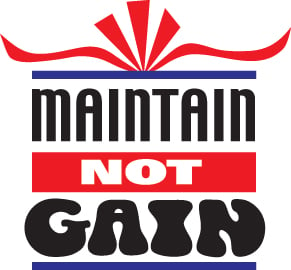
Give yourself a little bit of extra accountability by signing up for Maintain Not Gain. This program incentivizes members to maintain their weight throughout the holiday season. With group workouts every two weeks, weekly emails packed with nutrition and fitness tips to keep you engaged, and prizes for those who maintain or lose weight during the duration of the program. There is something that everyone can benefit from by signing up for this free program. Don’t miss out on this experience and mark weigh-in week on your calendar for November 1 to 7.
The Rowing Challenge
All in good fun, the rowing challenge never disappoints for a good competition year after year! It is pretty simple: pick a team and ROW! The team that rows the most meters per person and the team with the highest total meters rowed earns bragging rights as team winners. Joining a team is an excellent way to ensure you are getting in some extra bouts of cardio and caloric burn during the busiest time of the holiday season, which means you are earning yourself some leeway to have a little more room to indulge. Your team will be depending on you to row towards the win!
Look to sign up for a team November 10 to 23.
Free Fitness Assessment
Along with both of these programs, this is a great time of year to take advantage of your free fitness assessment and exercise plan from our team of Health Fitness Specialists. If you are looking for a new routine or just need a little more guidance we're here to help you.
Don’t let the holiday season get the best of you this year. Your fitness and nutrition habits do not have to completely derail. Let NIFS help you find the right balance between fitness, food and fun this year!
This blog was written by Stephanie Kaiser, NIFS Fitness Center Manager. To find out more about the NIFS bloggers, click here.
by Stephanie Kaiser, on Oct 7, 2014 12:10:30 PM
 High-intensity interval training is one of the hottest trends in the fitness industry. Here at NIFS we offer HIT classes to accommodate this method of training. These workouts provide a total-body workout with an emphasis on metabolic training. They are fast-paced and led by a certified fitness instructor. Read why Carla continues to come to HIT classes year after year.
High-intensity interval training is one of the hottest trends in the fitness industry. Here at NIFS we offer HIT classes to accommodate this method of training. These workouts provide a total-body workout with an emphasis on metabolic training. They are fast-paced and led by a certified fitness instructor. Read why Carla continues to come to HIT classes year after year.
SHARE YOUR “STORY” OR A BIT ABOUT YOURSELF IN A FEW SENTENCES:
I joined NIFS about five years ago and love the journey to being strong and healthy that has become my way of life. The trainers and instructors have given me the tools to continue to grow and meet my goals.
WHY DID YOU DECIDE TO START HIT?
I joined HIT for the challenge and was really scared that I would fail or be the only person who was not in perfect shape. But I found great encouragement from the HIT leaders and LOVE it!
SOMETHING YOU HAVE ENJOYED:
I enjoy trying a new movement or exercise and love working with a group. And I love that no one even considers my age as a deterrent.
SOMETHING YOU HAVE LEARNED OR SOMETHING THAT SURPRISED YOU:
I am stronger and more capable of meeting my fitness goals than I ever knew! With training, we can accomplish almost anything!
FAVORITE WORKOUT or EXERCISE FROM ONE OF THE TRAINING SESSIONS?
I like the functional movement exercises included in the workout and really enjoy the variety the class offers. I can’t imagine doing the same exercise every day.
WHAT ACCOMPLISHMENTS HAVE YOU ACHIEVED DURING YOUR TRAINING?
I love that I have gained strength and core stability.
TIPS YOU HAVE LEARNED ALONG THE WAY FROM YOUR TRAINER?
Never say never….I can do it! The encouragement from the HIT instructors helps to make me stronger.
HOW DO YOU STAY MOTIVATED?
I love feeling strong and that gets me out of bed to hit the gym in the morning.
ANY OTHER THOUGHTS YOU WISH TO SHARE:
The unexpected gift I received from HIT and working out is that I am much more of a risk taker in my personal life as well. Training does translate to other areas of your life, and when you succeed in accomplishing a fitness goal, the tools used will give you confidence in other areas of your life. BONUS!
This blog was written by Stephanie Kaiser, Fitness Center Manager and Health Fitness Specialist. To find out more about the NIFS bloggers click here.
by Stephanie Kaiser, on Sep 11, 2014 4:20:00 PM
 The 2014 NIFS Go Girl Triathlon Training Program was a huge success! With 36 program participants, we had the largest training group in the history of the program! Year after year, it is one of the most rewarding experiences to be a part of at NIFS. There were numerous stories from many of the participants that we could go on and on about. Megan Hollister is a second-year training program participant who was willing to share her experience about why she enjoys participating in the training program.
The 2014 NIFS Go Girl Triathlon Training Program was a huge success! With 36 program participants, we had the largest training group in the history of the program! Year after year, it is one of the most rewarding experiences to be a part of at NIFS. There were numerous stories from many of the participants that we could go on and on about. Megan Hollister is a second-year training program participant who was willing to share her experience about why she enjoys participating in the training program.
SHARE YOUR “STORY” OR A BIT ABOUT YOURSELF IN A FEW SENTENCES:
I am a registered dietitian and have belonged to NIFS for the past year. This was my second year training with NIFS for the Go Girl sprint triathlon and I absolutely love it! I’ve always been active in various sports, and tri training is a great challenge.
WHY DID YOU JOIN THIS PROGRAM?
I’m not the strongest swimmer and swimming with skilled swimmers gives me a challenge and also helps me to improve through their guidance and tips. On the flip side, I’m a strong biker and have been able to share my experiences with newer tri-athletes.
SOMETHING YOU HAVE ENJOYED:
The NIFS group feels like a team and it’s fun to train with people of all skill levels.
WHAT ACCOMPLISHMENTS HAVE YOU ACHIEVED DURING THE TRAINING PROGRAM?
My goal this year was to finish in less time than I did last year. I didn’t get to compete in the race due to illness, but I know my training would have allowed me to beat last year’s time!
TIPS YOU HAVE LEARNED ALONG THE WAY?
Best tip of the summer: Put your goggles on when your face and goggles are dry to get better suction! Another tip that I found helpful is to practice where you are going to race to be prepared for race day. For example, my favorite running routes are at Eagle Creek because it simulates the race and makes your legs work on the hills.
HOW DO YOU STAY MOTIVATED?
Every week my motivation was renewed when the newsletter came out, preparing me for the upcoming team workout. During workouts teammates shouted encouraging words when cycling by, or they’d say, “I’m going to catch you!” which is enough motivation to finish with a smile.
ANY OTHER THOUGHTS YOU WISH TO SHARE:
If you’ve ever thought about doing a triathlon and are unsure if you can do it or if you’re the “right type” of person to do it, you are and you should! The first triathlon I competed in, I had no idea what I was doing, I wasn’t in the best shape, and I had no real guidance. I completed it, I felt good, and I got interested—and then I found the NIFS program. It is perfect for those just starting out or those who wish to take it to the next level. If you think you can, you definitely can. You just have to “Tri.”
To learn more about NIFS Training Programs visit our Programs page.
This blog was written by Stephanie Kaiser, Fitness Center Manager and Health Fitness Specialist. To find out more about the NIFS bloggers click here.
by Stephanie Kaiser, on Aug 12, 2014 12:00:31 PM
 Over the past decade, there has been an increase in the popularity of barefoot training or training in a minimalist shoe such as a Vibram Five Fingers, especially with running barefoot. Along with this has come a lot of controversy about whether barefoot training is detrimental or beneficial. No matter which stance you agree with or practice currently, I think anyone would agree that it is important to have functional and strong feet and ankles.
Over the past decade, there has been an increase in the popularity of barefoot training or training in a minimalist shoe such as a Vibram Five Fingers, especially with running barefoot. Along with this has come a lot of controversy about whether barefoot training is detrimental or beneficial. No matter which stance you agree with or practice currently, I think anyone would agree that it is important to have functional and strong feet and ankles.
Going barefoot compared to wearing shoes will force your feet and ankle muscles to work harder initially, therefore making them stronger. It will also improve the mobility of the foot and ankle. Wearing a shoe takes a lot of the work away from the foot, which leads to dysfunction, imbalance, and weakness over time. This is all-important because your feet are what connect your body to the ground and ultimately play a contributing factor in your stability, posture, and balance.
For those who have not adopted a barefoot or minimalist shoe lifestyle, it is important to incorporate barefoot exercises into your workout routine to improve foot and ankle function and mobility for these reasons. Here are a few exercises to perform barefoot that you can incorporate into your exercise routine and see quick improvements!
Beginner: Work on single-leg balancing. Press your big toe, small toe, and heel into the ground equally and try to hold your balance on one foot for 20 to 30 seconds.
Intermediate: Once you are comfortable balancing on one foot,try catching and passing a ball to a partner or against a wall in the same position. This will further challenge your balance by adding in the element of movement in the upper body.
Advanced: Incorporate barefoot plyometric exercises. Be sure to reinforce activating the muscles in the foot by landing on the three points of your foot discussed in balancing. One example of a plyometric exercise is to jump over a cone on one foot and land on the same foot on the opposite side.
If you are ready to make exercise a priority in your life NIFS is here to help. Membership at NIFS includes a personal assessment and training programs designed for you by a Health Fitness Specialist. Try NIFS free for 7-days and see how we can help you make exercise a priority.
This blog was written by Stephanie Kaiser, NIFS Fitness Center Manager and Health Fitness Specialist. To find out more about the NIFS bloggers, click here.
NIFS blogs are written by our nationally certified and degreed staff on fitness subjects ranging from workouts to nutrition to how to live a healthy lifestyle. We hope you enjoy our tips and insight!